Bloomington – Louisville – Dayton Tour Stops Report
Posted: 26 Mar, 2016 Filed under: Uncategorized | Tags: Complementary currencies, conference, cooperation, cooperative, ecological economics, economic justice, mutual aid, Mutual Aid Networks, new economy, timebanking Comments Off on Bloomington – Louisville – Dayton Tour Stops ReportHello!
As promised, here are the reports on my tour stops in Bloomington Indiana, Louisville and Kenton County Kentucky, and Dayton Ohio. It’s been a whirlwind…
After leaving St. Louis, where we were graced with a great article on Mutual Aid Networks on the FRONT PAGE above the fold! of the St. Louis Post Dispatch, I headed to Bloomington Indiana for the Up & Coming Food Coop Conference. I went to this as part of the Board of Madison’s Allied Community Coop, the first MAN pilot site in Madison and the birthplace of several of the ideas that led to MANs.
the first MAN pilot site in Madison and the birthplace of several of the ideas that led to MANs.
I learned a lot of really valuable stuff at this conference, which I’ll do my best to encapsulate here. I also met great people doing great work, as usual.
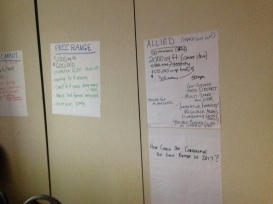 First, I went to a workshop on creating the timeline for your cooperative’s development.It’s really worth noting that most of the going advice that the cooperative development people are used to giving is geared toward maximizing likelihood of financial success in a model rooted in late capitalism, and is hard to apply to efforts that are rooted in a mission of feeding people who need food, and soon. The presenters are working hard to acknowledge and address this problem, but everyone has a lot to learn about how to create conditions for people in low-income food deserts, with little or no access to seed capital or means to access some of the specialized expertise needed – or time to devote to the massive amounts of work required to organize most anything, let alone a large operation like a grocery store – to build their own options.
First, I went to a workshop on creating the timeline for your cooperative’s development.It’s really worth noting that most of the going advice that the cooperative development people are used to giving is geared toward maximizing likelihood of financial success in a model rooted in late capitalism, and is hard to apply to efforts that are rooted in a mission of feeding people who need food, and soon. The presenters are working hard to acknowledge and address this problem, but everyone has a lot to learn about how to create conditions for people in low-income food deserts, with little or no access to seed capital or means to access some of the specialized expertise needed – or time to devote to the massive amounts of work required to organize most anything, let alone a large operation like a grocery store – to build their own options.
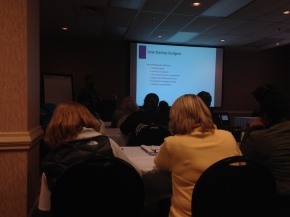 There were several cooperatives there who are working in conditions similar to Allied Coop, and it was really cool to connect with them and learn the cool things they’re doing.
There were several cooperatives there who are working in conditions similar to Allied Coop, and it was really cool to connect with them and learn the cool things they’re doing.
The timeline workshop was enormously instructive, going step by step into how you get a coop off the ground. It will really help to guide our work moving forward.
I also attended a workshop on finding and working with lenders and one on planning a capital campaign, both really eye-opening and good to understand more about how these kinds of large projects are funded, and what kind of relationship organizers are expected to have with funders. 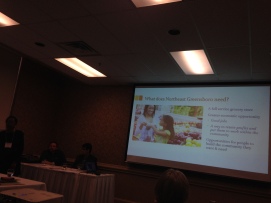
My colleagues from the Allied Board participated in a forum on cooperatives in low-income communities, building your coop’s leadership team, laying your coop’s foundation, and several of us attended the workshop on conventional food distribution.
The  rest of the crew needed to leave to get back to Madison, but I got to go to Malik Yakini‘s workshop on fostering a racially just food system, which was great. He’s doing so many things, many of which we’ve dreamed of and have been working toward in Allied. I hope to connect with him again soon in Detroit! during the NASSE forum. I also attended a great workshop with Renaissance Coop, a fantastic project just breaking ground in a food desert in Greensboro NC. They’re superstars right now, working to light the way for more grassroots efforts in communities that have been decimated by dog-eat-dog capitalism.
rest of the crew needed to leave to get back to Madison, but I got to go to Malik Yakini‘s workshop on fostering a racially just food system, which was great. He’s doing so many things, many of which we’ve dreamed of and have been working toward in Allied. I hope to connect with him again soon in Detroit! during the NASSE forum. I also attended a great workshop with Renaissance Coop, a fantastic project just breaking ground in a food desert in Greensboro NC. They’re superstars right now, working to light the way for more grassroots efforts in communities that have been decimated by dog-eat-dog capitalism.
After the conference closed I met up with Paul Burt, who found and got interested in Mutual Aid Networks because he has lots of ideas that dovetail with what we’ve been developing. He’s already been helping with great ideas for system design and applications and solid suggestions for getting our communications with the outside world into better shape. Working on it! Now with his help.
—
 I drove from Bloomington to Louisville that night, and went to the home of the wonderful Beth Thorpe! and her husband John, and dogs Lily and Mocha. Lovely family and visit.
I drove from Bloomington to Louisville that night, and went to the home of the wonderful Beth Thorpe! and her husband John, and dogs Lily and Mocha. Lovely family and visit.
Sunday evening we went to the Louisville TimeBank potluck, a pie-themed one for Pi Day. They did lots of cool things there, including a free table, cool re-purposed name tags made by one of their members, and I spoke about MANs and we generally had a good time.
The next day Stephanie Barnett hosted a lunch meeting at the awesome pay-it-forward 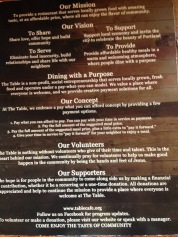
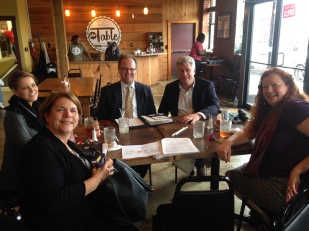 Table restaurant. There we met up with a lawyer and an accountant who are active with Louisville’s Compassionate City initiative (Kathy Perlow and I came for the launch!), and the director of Center for Non-Profit Excellence. We discussed how timebanking could further their efforts to foster collaboration among Compassionate City partners, and how Beth might be able to help. We also talked about Stephanie making her project into another health and wellness-oriented MAN pilot. Cool!
Table restaurant. There we met up with a lawyer and an accountant who are active with Louisville’s Compassionate City initiative (Kathy Perlow and I came for the launch!), and the director of Center for Non-Profit Excellence. We discussed how timebanking could further their efforts to foster collaboration among Compassionate City partners, and how Beth might be able to help. We also talked about Stephanie making her project into another health and wellness-oriented MAN pilot. Cool!
—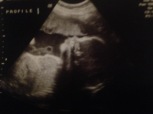
On Tuesday I went to Dayton to stay with my sister Gwynne and niece Ariel – who’s having a baby this June! So it was especially great to see her at this time.
Wednesday I spent working in the Kenton County Kentucky Planning and Development Services building, where Alex Koppelman hosted a meeting of potential partners in timebanking (and where I completely forgot to take pictures). Participants there are focused on: building networks of support among rural residents, supporting veterans and other homecomers, creating a more ecologically sustainable county, and enhancing natural supports in human services. We explored how timebanking can help meet their goals. We touched briefly on Mutual Aid Networks, but at this point timebanking can go a long way toward supporting their work, and will be plenty to do for now. Alex knew me from having studied DCTB in the course of his PhD work, and sees possible applications in through his work now as Associate Planner for Kenton County.
 On Thursday my sister Gwynne hosted a gathering at the Dayton church where she serves as music director. This was really cool! We had a full table of really engaged people, bringing the kind of diversity of skills and connections that could really make something
On Thursday my sister Gwynne hosted a gathering at the Dayton church where she serves as music director. This was really cool! We had a full table of really engaged people, bringing the kind of diversity of skills and connections that could really make something  go. From their wonderful pastor Cheryl to Maria of Su Casa, to Karen who works in the court system, to the many church members who have a variety of talents and experience, we had what we needed to have the group just offer up a great plan of action and start taking on roles to move it forward. Pretty great.
go. From their wonderful pastor Cheryl to Maria of Su Casa, to Karen who works in the court system, to the many church members who have a variety of talents and experience, we had what we needed to have the group just offer up a great plan of action and start taking on roles to move it forward. Pretty great.
— On from there to Washington DC, Allentown and Bethlehem PA, Philadelphia PA, and NYC for a visit (and catching up on this report writing)… which I’ll report on soon. For now it’s more important to get outside while it’s sunny. 
Our abstract for the Hague
Posted: 14 Feb, 2013 Filed under: Uncategorized | Tags: Complementary currencies, conference, papers, trophic analysis Comments Off on Our abstract for the HagueAs Steph announced below, our abstract was accepted at the 2nd International Conference on Complementary Currency Systems in the Hague in June. For anyone interested, here’s the abstract we submitted. It builds upon the paper we presented in Lyon back in 2011 while laying out our basis for the community experiments we’re preparing to instigate:
Previously we offered a trophic model for thinking about the relationship between different types of currencies and exchange mechanisms and how currencies assist and hinder the recognition of value and wealth. In our model, different currencies express unique perspectives on that which is valuable to an entity, such as how the rabbit values the carbohydrates found in the grass while the wolf values the proteins found in the rabbit. The protein may be more energetically powerful and rare than the carbohydrate, but the former cannot exist without the latter. In its turn, the carbohydrate cannot exist without the abundance of sunlight which the plant uses in their production. The scarce is the outcome of the abundant and cannot exist without it. Wealth, then, is that which is collected and aggregated on the basis of individual identification of what is valuable. Value itself transcends any individual definition and exists as an imminent potential. Through our model we assert that an economic system may be understood and empowered by recognizing that currencies like the dollar, apex species in our model, occur on the basis of a vibrant ecology of different forms of exchange and relation. Community development should be focused on the expression of potential rather than the measurement of dollars. We have since developed our model further, in part to address concerns of how to put our ideas into practice. Thus, we offer a variant which operates outside of spatial definitions of currency — local, national, supranational — to instead consider intermediary objects that we think of as currency: time, grain, gold, and so forth. We suggest in part that our common error to think of gold or other scarce commodities as symbolic of money itself, rather than as a type within an ecology, leads us to create alternatives set up to fail. By modeling community currencies off national currencies we are effectively putting a wolf on a leash and expecting it to compete with those running wild. Instead, we suggest that community currencies need to embody a different set of properties such as are expressed through grain, time, gift, and the commons — currencies which decay and replenish, not those which persist and require us to decay in their stead. More, we need to recognize the fundamental differences between these money objects and how they represent, and fail to represent, knowledge that we have of each other and our communities. The jaundiced money and debt of empire, predicated on distrust, has little place in our communities and homes. In addition, as we seek to address questions of community renewal, we need to recognize that our immediate answers are not of economics but of the types of societies in which we desire to live. The economic question follows from the social question. Through the Time For the World project, we are currently developing a distributed experiment in community production to test and investigate these ideas. Our paper will document outcomes and launch our model for large-scale dissemination and replication.
Now we just need to write it!
Sharing Builders Workshop #7: Healthy Community Economy Part II
Posted: 23 Oct, 2012 Filed under: Builders Workshops, Presentations, Uncategorized | Tags: Community currencies, community development, Complementary currencies, conference, cooperation, cooperative, ecological economics, mutual credit, timebank, timebanking Comments Off on Sharing Builders Workshop #7: Healthy Community Economy Part IIHello!
Builders Workshop #7: Healthy Community Economy Part II was a great wrap-up of our explorations, from the Healthy Community Economy Part I workshop as well as the intervening Economic Democracy Conference, of how multiple currency/cooperative economic models could work in concert to achieve powerful community goals. In the Economic Democracy Conference open space Action Summit session we applied this thinking to the outcome of food security.
In Builders Workshop #7 we applied similar thinking and modeling to the goal of reduced fossil fuel consumption.
We had 14 people in attendance. While smaller in number than other Builders Workshops, this group proved to be a perfect size and makeup for the work that we needed to do. I was particularly excited that David Boetcher, an IBEW electrician who co-presented (with Justice Castaneda of MIT Colabs and Chris Meyer of Sector67 co-working space) the New Approaches to Science and Industry workshop at the Economic Democracy Conference, attended and contributed his knowledge of energy systems, surrounding economies and potential partners.
First we gave a slide presentation that recapped and expanded on pieces from Healthy Community Economy Part I.
It’s shared here.
Then we decided to use a case study of a hypothetical community goal in order to see how we might apply different cooperative economic tools to different pieces of the systems we’d need to affect to achieve our desired outcome. The group chose reduced fossil fuel consumption as the focus area. This is what we came up with, sort of a general map of where each piece would be employed to corral various types of resources, finishing with people taking on pieces to research/explore potential partnerships. 

 In the rough maps in the first and second slides M$ stands for Madison Hours and/or price-based mutual credit; T$ stands for timebank hours. The first map was the brainstorm, the second was an attempt to show some chronological representation of how you would develop the project.
In the rough maps in the first and second slides M$ stands for Madison Hours and/or price-based mutual credit; T$ stands for timebank hours. The first map was the brainstorm, the second was an attempt to show some chronological representation of how you would develop the project.
As you’ll see from the third photo, we were blessed with participants who offered to carry some work forward! So some of us will be researching existing renewable energy/efficiency efforts, some will research JAK-style bank community saving and lending possibilities, some will be meeting with local businesses to pursue price-based mutual credit and Madison Hours possibilities, and some will be meeting to explore a potential energy project here in Madison.
Stay tuned for further developments…
And follow it all on Build For the World (and post your own projects there – we need to learn from each other!), http://buildftw.org
Thanks for reading,
Stephanie
Deploying Time Banking for Human-Scaled Economic Development: Video
Posted: 7 Apr, 2011 Filed under: media, Presentations, Uncategorized | Tags: Community currencies, community development, conference, ecological economics, hierarchies, networks, timebank, trophic analysis 1 CommentIn February we gave a presentation at the International Conference on Community and Complementary Currencies in Lyon, France. Here is video and our slideshow from that presentation. Let us know what you think! We continue to build on and advance on this work as part of the project.
It is best viewed full screen.
Time for Lyon
Posted: 17 Feb, 2011 Filed under: Presentations, Uncategorized | Tags: alliance, conference, international, timebanking Comments Off on Time for LyonWell the day has come – Stephanie and Marc are finally traveling to Lyon to present our paper at the Complementary Currencies conference, then to Tiocan to meet with other complementary currency folks to see what we can do together.
First, Our intention in going to Lyon is to learn all we can about what’s currently happening with complementary currencies, what’s happened in the past, and how we can use that knowledge to create a better future.
Second, and why we’re making the trip – we see an urgent need to ensure that timebanking and its values-based inclusive properties be included in our economic future. We’re big fans of lots of models of complementary currencies, but also recognize that most continue to focus on the kinds of exchanges that normally happen in the marketplace. That may continue to exclude or inadequately meet the needs of the core economic functions of caregiving, creativity and civic engagement. By joining forces with other complementary currency systems and actors, we can create something that is more effectively complementary – that makes room for all people in our economy and uses appropriate tools for appropriate exchanges.
For example, since caregiving is both abundant and widely needed, we want an abundant medium of exchange to facilitate needs being met. Timebanking is perfect for this. But storefront space in our downtown is scarce – so it stands to reason we would use a more competitive, price-based currency for conducting business activities in our cities to best allocate such a resource.
Third, we’re going to meet lots of people who have similar interests, with huge bases of knowledge that we haven’t yet learned of and lots of connections with others who share our goals.
After the main conference, there is a day for Complementary Currency actors and on this day we really expect to find some people to work with into the future, creating and maintaining an international learning community and identifying ways we can work together to create the systems and tools we need to succeed in creating a human-centered economy that values people and the planet.
Once the conference is over our work in Europe still continues…
Feb. 19 and 20 we’ll meet with more complementary currency actors near Geneva, in an action-oriented conference hosted by Matthew Slater of Community Forge. Once again we’ll have an even more in-depth opportunity to see what we have, what we need, and what we can do together to push our collective work out into the world.
Yay! We’re presenting at CCConf2011 in Lyon
Posted: 9 Nov, 2010 Filed under: Uncategorized | Tags: conference, eu, outreach, papers 5 CommentsWoo Hoo! Our abstract was accepted to present at the International Conference on Community and Complementary Currencies in LYON
February 16, 2011 – February 17, 2011
Looks like we’ll have to actually write the paper (and raise enough money to go!)
Here’s our abstract:
Deploying Timebanking for Human-scaled Economic Development: Abstract
Stephanie Rearick, Preston Austin, Marc Brakken
Timebanking, a values-based system of equal exchange of time, has taken root in 34 countries to date and has demonstrated a resiliency and demographic inclusiveness not commonly seen in complementary currencies. Moreover, timebanking values as core economic functions many activities, such as caregiving, civic engagement and creativity, that are undervalued when commodified in the market economy, including in market-based complementary currencies. By providing an appropriately abundant and fungible means of exchanging these core economic functions, timebanking increases the economy’s ability to appropriately allocate resources. Economic tools that fail to value these functions, or treat them as market-based commodities, will frequently replicate many of the social problems our current monetary system generates.





